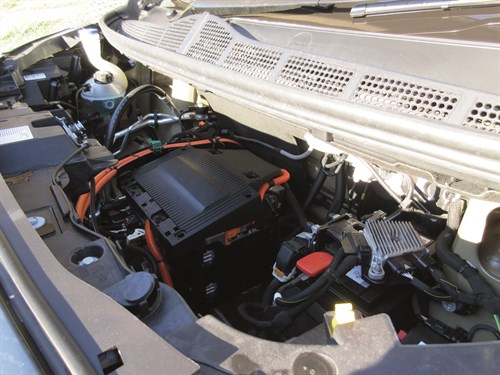- ETRUX launches new Ford E-Transit Trizone
- Renault gives UK debut to Master E-Tech at CV Show
- Isuzu D-Max long-term test – Latest Report
- Isuzu D-Max V-Cross Steel Edition revealed
- IVOTY Report: Stellantis explores the hydrogen proposition
- New Maxus EVs include eDeliver 5 van
- Used LCV values reach six-month high
- ADVERTISEMENT FEATURE: IVECO Daily Mission Awards 2024 Q2 Round-up: Grounds Maintenance & Forestry
- Stellantis Pro One electric vans review
- Mitie adds 5,000th EV to fleet
The What Van? Road Test: Citroen e-Dispatch
Date: Wednesday, June 23, 2021

Powertrain
The lithium-ion battery pack powers
a 100kW (136hp) electric motor married to a single-speed gearbox. Maximum torque is 260Nm and is instantly available.
Lift your foot off the accelerator whenever you are descending a hill and the regeneration function pumps energy that would otherwise be lost into the battery. Every little bit helps, and the dashboard display tells you if your actions are boosting the battery’s charge level.
It also lets you know if you are driving economically or guzzling a lot of juice.
Driving
Perhaps surprisingly, the e-Dispatch comes with a conventional ignition key even though it doesn’t have a conventional ignition. You insert the key, then turn it until a sign on the dashboard display illuminates and tells you everything is ready.
Engaging D for drive couldn’t be easier. All you need to do is flick a switch between the driver’s seat and the adjacent passenger seat, and you are good to go.
Think carefully before you opt for an e-Dispatch if you spend a lot of your time on the motorway, though. When we took it down the M50 at a steady 65–70mph we saw the projected range rapidly drop, even though we were lightly laden.
To maintain our range we selected the van’s Economy setting whenever possible, which restricts motor power and torque. By doing so, you are draining less charge from the battery pack.
Although your motorway performance is reduced, the cut cannot be classed as dramatic unless you are tackling a lot of hills with a heavy load on board.
So far as we were concerned, given that the van was being driven in chilly weather, the reduction in output from the heater was more noticeable. The cab takes a while to warm up first thing anyway, so don’t forget your scarf and gloves on colder days. The Eco setting cuts the air-conditioning’s output as well.
Two other settings are available: Normal and Power. The latter gives you a lot more impetus if you are attempting to overtake slow-moving traffic – you feel a hefty shove between your shoulder blades as you accelerate – but range suffers accordingly.
Stick to Normal and you will find you have sufficient performance for most eventualities.
The van’s handling is surprisingly sharp, but the ride is rather lumpy if you are less than half-laden. The electric motor’s understated whine is less intrusive than the typical diesel engine rumble, but the lack of noise from beneath the bonnet means that the decibels generated by the tyres, the creaking of the suspension and the wind become far more noticeable.
There are no squeaks or rattles from the body, however; the build quality is good.
Pedestrians and cyclists will of course hear next to nothing from the van and may stray into its path as a consequence. To guard against this risk, the e-Dispatch is fitted with an acoustic vehicle alerting system.
It generates artificial sound when the vehicle is travelling at low speeds so that vulnerable road users know it is heading their way.
View The WhatVan Digital Edition


